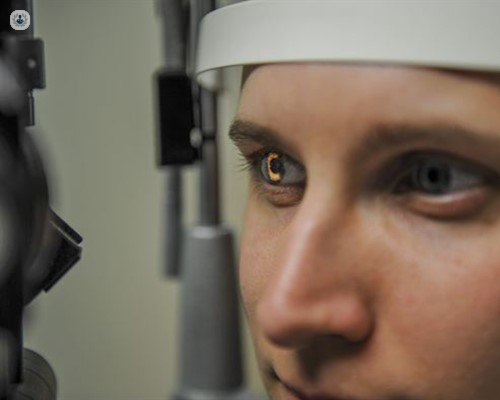YAG laser iridotomy
Mr Abdallah Ellabban - Ophthalmology
Created on: 08-23-2022
Updated on: 10-09-2023
Edited by: Kate Forristal
What is a YAG laser peripheral iridotomy?
A YAG laser peripheral iridotomy is a laser eye procedure whereby a very tiny hole (opening) is made in the iris (the coloured part of the eye) with a special type of laser. This hole is called “iridotomy”. The hole is not normally visible with the naked eye, as the surgeons performing the YAG laser peripheral iridotomy usually aim to place the hole under the patient's upper eyelid in the peripheral iris.
Ophthalmologists are the medical professionals trained and specialised in performing this procedure.

Why is YAG laser peripheral iridotomy typically performed?
YAG laser peripheral iridotomy is indicated for patients who may have a narrow anterior chamber angle or who are at risk of developing a condition called primary angle closure glaucoma. The area between the cornea, clear front part of your eye and the iris, colored part inside the eye, is called the anterior chamber angle. Some patients, for one or more reason, may have a narrow anterior chamber angle.
The narrow angle can get blocked in certain situations, and this may compromise the drainage of the fluid inside the eye. This will lead to a sudden rise in eye pressure causing a condition called primary angle closure glaucoma or “acute glaucoma”. High eye pressure, if untreated, can damage the nerve of the eye and may lead to permanent vision loss.
The aim of the hole or iridotomy is to assist fluid to flow from the front part of the iris to the other side and then out of the eye through drainage channels called the “trabecular meshwork”. This will dramatically decrease this risk of angle closure. YAG laser iridotomy can be also used to treat some patients who have been diagnosed with certain types of chronic glaucoma called secondary angle closure glaucoma.
How will I know if I have narrow angles?
The diagnosis of narrow angles is usually picked up on a routine examination by the optician or by an eye specialist. The optician may refer you for an eye specialist opinion if he feels the angle of the front part of the eye is narrow or the eye is at risk of angle closure. You may have no symptoms at all. However, some patients may report episodes of blurred vision, halos around light, or occasional headaches that can occur while watching TV in a dark room, reading or after emotional stress.
How is it performed, and how long does it take?
YAG Laser Iridotomy is usually performed at the eye clinic. Initially, the doctor will put some drops to make your pupils small. Then you will be taken to the laser treatment room. You will be asked to sit on the laser machine which is very similar to the eye examination machine used for check-ups. The doctor will put some numbing drops and put a special contact lens to stabilise your eye during the laser treatment.
The doctor may also put some drops to lower the eye pressure before or after the laser treatment. Then, the laser is then carefully applied to make the hole in the iris. During the laser treatment, you may see some bright lights and you may hear some clicking sounds. This light is designed to assist the doctor when applying the laser. The laser treatment takes only a few minutes. The treatment is not painful and is effective in most cases. The treatment can be done for one eye at a time, or both eyes at the same sitting.
What happens after laser treatment?
Following the laser treatment, you will be asked to wait for about 30 minutes for the doctor to check the eye pressure and to confirm the hole made in the iris is working effectively. You will be given some anti-inflammatory drops to use at home for between one to two weeks after the laser procedure. The doctor may arrange to review you again in two to four weeks to check the eye pressure and to make sure the laser hole is working correctly.
Are there any risks involved with the procedure?
The procedure is a very safe one, but, like all surgical procedures, there is a small risk of complications. The main ones include the following:
- temporary inflammation
- raised eye pressure
- small bleeding from the iris
- development of cataracts
Is there any alternative to YAG laser peripheral iridotomy?
For patients who might feel that YAG laser peripheral iridotomy is not quite the right procedure for them, there are two main alternatives that patients can consider.the other option is to perform lens extraction surgery (similar to cataract surgery).
Their risk of angle closure may increase over time as the lens inside the eye continues to increase in size with age. Therefore, lens extraction can help to open the angle of the eye and prevent angle closure. A large research study called the EAGLE study found that early lens extraction can be an alternative to YAG laser peripheral iridotomy treatment and can be used as an initial treatment.
What is recovery time like?
Thankfully, patients can normally resume normal daily activities almost immediately after the procedure. As the patients' vision may be slightly blurred after the YAG laser peripheral iridotomy, they will be discouraged from driving home afterwards. They can, however, normally begin driving again the day after the procedure.



